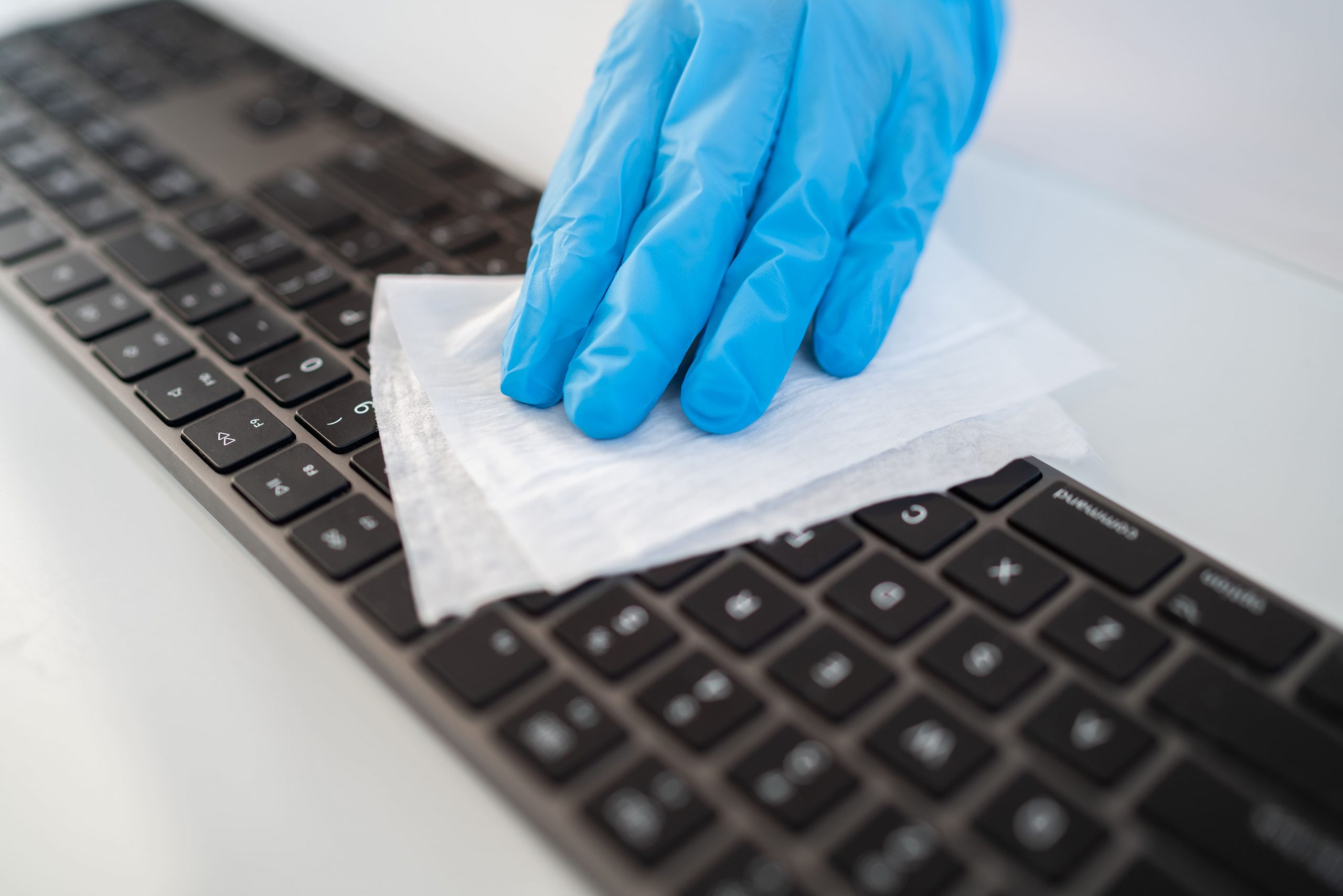
How To Clean & Disinfect Common Touchpoints?
Infectious droplets collecting on surfaces is one of the biggest sources of Covid transmission. Working in an office means interacting with high-volume touchpoints and increases the risk of staff coming down with an illness. Whether it’s the common cold, the flu, or coronavirus, the risk of transmission in the workplace can be dramatically reduced by cleaning and disinfecting surfaces.
Office kitchen worktops, door handles, and desks are all areas that require regular cleaning and disinfecting. Cleaning removes dirt, debris, and germs from the surface or object that’s being cleaned. While disinfecting uses cleaning products, with specific chemicals, that kill the germs on a surface or object.
Cleaning and disinfecting surfaces reduce the risk of a virus infecting anyone who comes into contact with a high-volume touchpoint. A professional office cleaning service can scale to match the size and requirements of any business and have access to specialist cleaning products. Expert cleaning professionals understand what the right equipment is to protect themselves and the surfaces they’re working on. The cleaners will also wear appropriate PPE, including high-quality masks and gloves, to ensure everyone’s safety.
To understand the most effective and safe ways to clean common touchpoints and surfaces to remove infectious droplets of coronavirus, keep reading our list below.
Cleaning and Disinfecting
Any dirt and dust need to be removed from surfaces and objects regularly. However, cleaning and disinfecting surfaces has become even more important because of the pandemic. Doing this process correctly not only ensures the surfaces retain their quality and durability over time, as well as managing their appearance, but protects people from contracting Covid-19.
Deep cleaning after a positive coronavirus test result is essential. Don’t delay conducting this process, contact a specialist Covid-19 decontamination service ASAP. If you wait, this increases the risk of the virus being passed on to others. Deep cleaning involves ULV fogging to eliminate airborne contaminants as well as cleaning and disinfecting surfaces. Afterwards, the cleaners will use ATP swabs and Quat testing to confirm any infectious droplets are no longer present.
Disinfecting a surface removes any harmful microorganisms, so the risks posed by any other viruses or bacteria will be reduced as well not only Covid-19.
Avoid Contamination
A surface becomes a vector for Covid transmission if it’s a touchpoint. Doorknobs, light switches, and taps are all high-touchpoint surfaces so are a big risk of transmission. Think about all the surfaces and objects many people regularly interact with in an office. There are often too many to count, so contamination becomes a big risk. However, thorough hand washing and sanitising reduce this risk. Encourage staff to wipe down any surfaces after they’ve interacted with them, for example, a phone system or their workspace on their desks.
When an infected person has come into contact with a surface it becomes contaminated. While waiting for a professional deep clean to be conducted, quarantine the area to reduce the risk of transmission. If possible, restrict access to the room or areas that have been contaminated. While you may not be able to completely quarantine an entire area, you can mitigate the risk of transmission by putting up barriers, signs, or coverings. If someone has to interact with a surface, make sure they wear gloves and dispose of them safely.
Mitigate the Risk
If a deep clean is not possible, quarantine the contaminated area for at least 48 hours as this is how long experts believe infectious coronavirus droplets survive on most surfaces. Although the risk of contracting the virus steadily decreases over time, maintain the quarantine for 48 hours or wear PPE if contact is necessary.
Depending on the material, the virus has the potential to survive for longer on certain surfaces. Make sure you have the relevant information before removing any quarantine measures. After you’ve kept the area isolated for the appropriate time, a deep clean that disinfects all surfaces isn’t necessary. However, you should still conduct your standard cleaning routine while wearing PPE.
Manage the Risk
If cleaning and disinfecting surfaces is possible, you must manage the risks. The cleaner needs to wear full PPE to reduce the risk of transmission occurring. Using the right methods and cleaning products is also important to prevent damaging the surface. A professional cleaner can assess the surface, identify the material and whether it has a surface finish, and assess its condition.
Cleaning without extensive research on the correct products and methods may be ineffective. You may not clean and disinfect surfaces properly, meaning infectious droplets of coronavirus still pose a risk. It’s essential that the right disinfectant is used for whatever surface you’re cleaning, so if you’re in doubt, get in touch with a professional.
LCS Cleaning and Disinfecting Surfaces
Find out more about how to clean all surfaces in your workplace safely, get in touch with our team today. At LCS, we’re cleaning experts who can advise on the right materials and methods to use. Our team can also conduct effective cleaning and disinfecting that also protects the surface from damage.
Call us on 01604 926004 or visit our contact page today for more information.